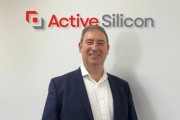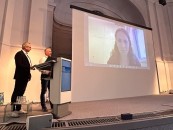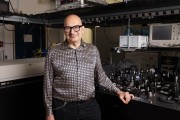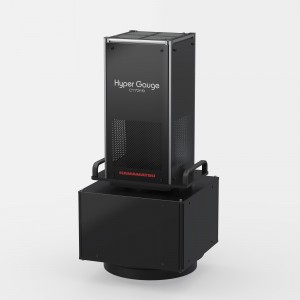
In this interview, Antonio Castelo, EPIC’s Technology Manager for Bio-Medical and Lasers, talks to Dr Michal Nejbauer, CEO at Fluence Technology, a Polish manufacturer of unique all-fiber technology for medical, industrial, and scientific applications.
What’s the background to your appointment as CEO at Fluence Technology?
In 2001, I went to Warsaw University to study for an MSc in Optics. My Master’s thesis was on femtosecond laser technology under the supervision of prof. Czeslaw Radzewicz who pioneered femtosecond lasers in Poland back in 80’s. I had the opportunity to build a Ti:sapphire regenerative amplifier and a complete chirped pulse amplification system from scratch, which was a unique experience.
In 2007, I moved to the Polish Academy of Sciences to study a PhD in ultrafast Raman spectroscopy. For the next 9 years, I simultaneously worked as an assistant researcher, but I spent most of my time at an optical table, building lasers and understanding optical phenomena related to them. I wrote some academic papers, but my passion was always to develop a technology that could be used in the real world to solve real-world problems.
Towards the end of my PhD, I began talking to some colleagues about creating a company to commercialize the femtosecond technology we’d been working on. I was offered to continue my career at Oxford University, but I thought the entrepreneurial path of developing commercial laser applications would be more exciting. Accordingly, in 2016, I co-founded Fluence Technology with three colleagues, also ultrafast laser experts.

How has the company developed?
When we started in 2016, people said there were already too many big names in the market and we’d never be successful. I had doubts initially but soon realized that we had a fantastic, unique technology with a perfect market fit. Specifically, we developed unique all-fiber laser systems that minimized the use of free-space optics and were extremely environmentally stable and immune to shock and vibration. For example, our 1030 nm ultrafast oscillator uses passive interference for mode-locking (PIM), eliminates degradable components such as SESAM, and can operate at accelerations as high as 40g and in temperatures ranging from -10°C to 40°C.
We knew that these features would give our lasers a competitive edge, and we’d be able to fill the long-standing market gap for service-free femtosecond lasers, particularly for industrial micromachining. Over the past 7 years, we’ve developed a range of all-fibre femtosecond lasers and an oscillator that comes with a 5-year warranty. Additionally, we supply a compact optical parametric amplifier as well as an ultrashort laser pulse characterization device to provide a high-resolution measurement for ultrafast oscillators and amplifiers.
Over the past 7 years, our workforce has grown to 55, we’ve doubled production year by year, and we now have distributors in the US, Europe, China, Japan, Korea, and Taiwan. Industrial micromachining is our main market, followed by scientific and bio-medical applications.
Are there any challenges being in Poland, which is not traditionally known as a laser producer?
Poland has always been active in laser development in academia, following trends and latest discoveries as early as the 1970s, nurturing knowledge from one generation to the other. There wasn’t much room for founding tech companies in the old communist era until it ended. Few photonic companies emerged just after. But the new generation must come, equipped with business knowledge, supported by VC’s, to start new tech businesses. Fluence is one of them.
We’re no longer seen as a third-world country as we were in the communist days. Nowadays, our technology is trusted around the world, and we sell on 5 continents. I’m proud to be one of the pioneers in deep tech in Poland that can be an example for others to follow.
How have you managed to fight against the well-known femtosecond laser brands like Light Conversion and Coherent?
I have always admired big brands; they are the inspiration for me. The main differentiation between free-space and fibre laser technology is like the comparison between a mature diesel car and an electric car: we are more like an electric car. Maybe our range of parameters is not that wide because femtosecond fibre lasers are quite limited by pulse energy. But we are continually pushing these limits, and we have chosen a technology to meet growing market needs for micromachining.
Do you think there is still some resistance within industry to move into the ultra-fast domain?
We deal with two types of customers. First, there are those who are already aware of the advantages of femtosecond lasers and the companies that provide them. For these customers, we focus on the superior parameters and quality of our femtosecond technology, particularly for micromachining, together with our speed and flexibility. Admittedly, femtosecond lasers are still relatively expensive, but as the technology becomes more widespread and more mature, we are confident of reducing costs further.
The second type of customers are those who are completely unaware of the benefits of the technology and who need to be educated. For these customers, we have teams working in our application laboratories dedicated to demonstrating what our lasers can do to solve customers’ problems.
What have been your personal challenges?
As CEO with ultimate responsibility for all areas of the company, my main challenge has always been to know when to intervene in a decision or in relation to the performance of the team and individuals. In general, I'm very tolerant and patient and prepared to wait for the results of an action. But sometimes, I think I’m too patient and should intervene sooner.
What are your main future challenges?
I'm a bit concerned about the power of some of our big competitors already installed in our potential customers. They’ve spent years building relationships that in most cases, are difficult to break. But there are companies who have never dealt with femtosecond laser manufacturers before, and these are the ones we will continue to focus on – establishing good relationships and building the company with them. Later on, we’ll focus more on the older players, by which time we’ll hopefully be a mid-sized company.
Do you think Fluence will be involved in a merger or acquisition or is your goal to be independent for as long as possible?
It is obvious that our technology may be very attractive to be acquired by others, but at the moment, our goal is to remain fully independent, to follow our own path and write our own history. Of course, we may be made an offer we can’t refuse, but only when we are sure it will have a positive impact on our customers. Whatever happens, we want the Fluence brand to become so well known that the Fluence name will continue, whoever the owner is.
What’s your advice to the next generation of entrepreneurs?
There are basically two options you can follow. You can go either into a niche market where there's almost no competition and where you can develop your technology peacefully with the customer. But this approach is risky as growth will be slow and may never take off. Alternatively, you can try to enter an emerging market where there`s much competition and very strong dynamics. Don’t be afraid of following this path, because, as we have proven, it’s never too late to enter an emerging market, provided you have a unique product and a skilled team behind you.
Whatever you approach, it’s better to have a team of people around you so you can share the responsibility of driving the company forward, knowing that you’re not alone in caring about the company's future. I'm happy to have three co-founders and well-motivated managers who deal with all the problems a deep tech company faces every day.
Written by Antonio Castelo, EPIC’s Technology Manager for Bio-Medical and Lasers.




































 Back to Features
Back to Features



























